Runner-Up Review: These Powder Skis Almost Made our 2022 Winter Buyer’s Guide
Our ski testing begins a year before the print version of the Winter Buyer's Guide lands in your hands. First, our test directors sample a handful of new skis from smaller companies to see if they'll be competitive. In December, we get a first look at all of the next year's skis with an on-snow media event in Colorado. Then the real fun begins: our own editorial ski test in Steamboat Springs. Manufacturers from around 24 brands arrive at the venue with skis in hand. After skiing a million-plus vertical feet over three days, we crunch the numbers. Only the best powder skis make the cut. Here's the best of the rest.
The powder ski category encompasses two subcategories: pure powder and all-mountain powder. Pure Powder skis are true fatties made for ginormous storms, snowcat trips, Alaska, and deep-winter backcountry skiing. They're ideal for spending 90 percent of your time off trail and 10 percent on trail.
All Mountain Powder, on the other hand, is anything around 105-millimeters underfoot. These skis are adept at floating on storm days and smearing turns in the trees or on steeps, but thanks to years of refinement, they also rip turns on hardpack with enough aplomb for daily resort skiing out west. Choose a ski from this category if you ski off-trail in soft snow 70 percent of the time and rip turns on groomers or hardpack the other 30 percent.
Best Unisex All Mountain Powder Skis
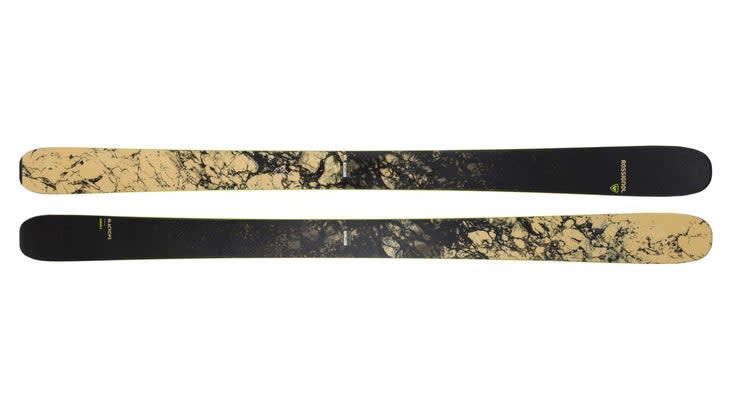
Rossignol Black Ops Sender Ti ($900)
Dimensions: 137/106/128
The era of excessively rockered skis with floppy tips is over. Skis with gradual rocker, a bit less taper in the tip and tail, and deep flex but stout edging have one-upped the old status quo. Here's why: That old banana rocker plowed through snow more than it would plane on top. And because it was nearly impossible to get such wildly elevated shovels and tails to engage (the rocker wouldn't touch the snow even in a deep turn), all you could do on groomers was eke out half arcs underfoot. The Sender Ti--and to be fair, the top five skis in this category--is the fix. "Anyone who lives and skis out West will love this new-age powder ski," said a tester. It's almost as easy to smear around as the old Rossi Seven series skis, but when it's time to charge, the Ti delivers with tip to tail edging. Beyond the new shape and silhouette mentioned above, the credit for this superb ride goes to the layers of viscous rubber material that bifurcates the wood core lengthways. The strip, which Rossi calls Line Control Technology, lets the ski contour and track on edge, while limiting the transmission of vibration across the width of the ski. The result is a silky ride at all speeds.
Gripe: This version with two sheets of titanium alloy isn't as playful for slashier skiers.
Like: Rossi makes a Sender without the metal for that crowd.
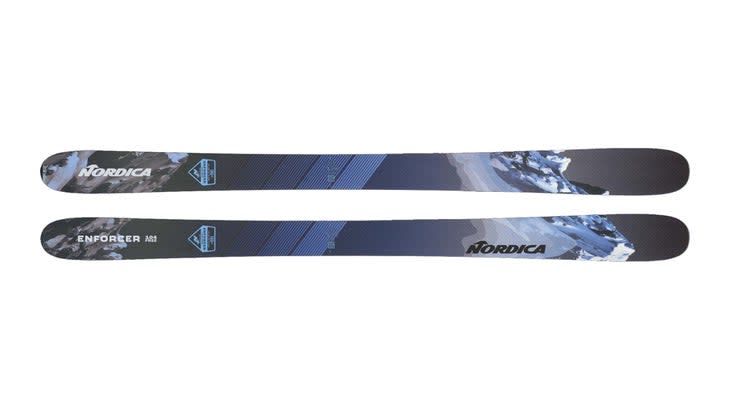
Nordica Enforcer 104 Free ($900)
Dimensions: 135/104/124
When this ski was introduced a few years back it upended the All Mountain Powder category. At our 2021 Steamboat test it was within a few decimal points of winning its class outright. Why so much long-lasting praise? To make skis over 100-millimeters underfoot enjoyable to ski on, the engineers and designers have to think about reducing overall weight. But Nordica's designers refused to sacrifice brand hallmarks like stability and edgehold for the sake of playfulness and a lighter feel. Their fix was to run lightweight balsa wood cores from tip to tail for the weight savings, and then back that up with two sheets of titanium alloy. The Austrian brand was also at the forefront of scaling back rocker and taper, so that when the ski is put on edge it actually engages. Not that it doesn't surf and slarve when you want it to. Those fat tips rise to the surface without plowing, which makes for a faster and smoother experience. Of the top three skis in the category, the Enforcer 104 Free is the one best suited to off-trail shredding, but it still rips a clean arc on groomers. "The versatility of this ski is off the chart," said a tester. "Maybe it doesn't carve quite as well as the Ranger 102, but in real-world resort powder, crud, and chop, it can do no wrong."
Gripe: We'd like it to pull through the exit of the turn just a bit more on the groomers.
Like: But then again, that might diminish its smear-ability off-trail, so never mind.
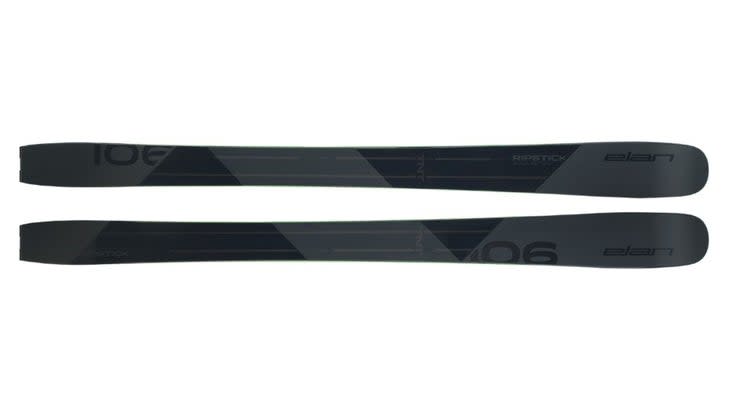
Elan Ripstick 106 Black Edition ($1,050)
Dimensions: 143/106/120
We loved the original Ripstick 106 for its accessible flex and silky but powerful ride quality. But truth be told it washed out a bit on true hardpack, especially at higher speeds. The souped-up Black Edition is just as fun as the OG, but to our testers it feels (roughly) 20 percent more energized and at least 10 percent more powerful on edge. That boost in performance comes from smartly placed carbon above just the inside edges--the Ripstick is asymmetrical, so there's a dedicated left and right ski--that cranks up the torsional rigidity for edge bite and rebound, but not so much that the ski gets unwieldy. Internal carbon tubes that are about the diameter of a pencil also help keep the 106 hanging on at the apex of the turn--it doesn't wash out--so you can ride that energy back across the hill. Off-trail, the 106 Black Edition is a shapeshifter. The rocker is more pronounced on the outside edges, creating shorter effective contact points that allow you to scrub speed with abandon in soft snow or crud. It's hard to catch an outside edge no matter how hard you try to. "Absolute charger on the groomed snow," said a tester. "But you can whip them around all day off-trail."
Gripe: Our biggest and fastest skier detected a speed limit.
Like: "It has a crisp feel that's all its own," said a tester. "It makes you want to push harder."
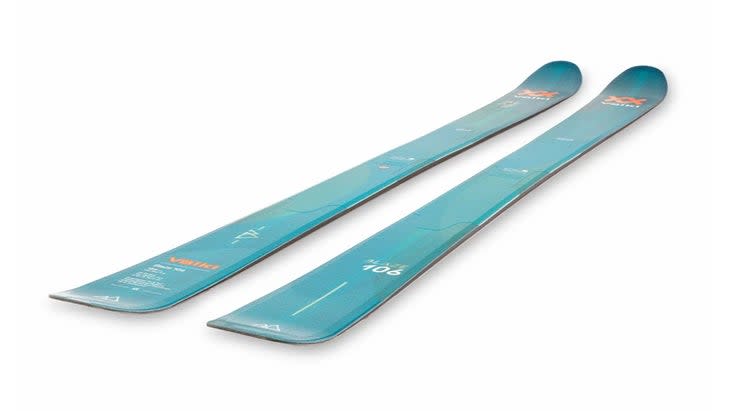
Volkl Blaze 106 ($700)
Dimensions: 146/106/128
The Blaze 106 was so well received in our Crossover category last year--it won the class--that Volkl entered it as an All Mountain Powder contender for winter 2022. Damn if it didn't hold its own, despite the fact that it was originally meant for high-performance backcountry skiing. Designed by a former women's World Cup racer with the backcountry bug, the Blaze is light enough for touring, but rips the descents too. Those traits technically make it a freeride ski (crossover to us), but it's best not to get too prescriptive with the labeling. "The Blaze literally blazes turns, but it surfs too," said a tester who had it ranked as his top ski of the day. What makes this ski so unique? If we had to guess, it's the combination of polyurethane material in the tip that soaks up vibration, and a tip to tail wood core (no goofy inserts) that gives the Blaze a consistent and predictable flex. The twin titanal binding plates underfoot--it's the only alloy in the ski--let the Blaze store and release energy from turn to turn. We've now skied the 106 extensively in backcountry pow and inbounds on the firmest snow. It's the template for a crossover ski. Mount it with a Duke PT binding and the dream of the one ski quiver is real.
Gripe: If you find yourself on true boilerplate, you might want a ski with more metal in it. But hopefully you already have that in your quiver.
Like: "This is the best ski Volkl makes," said our test director. "I'd ski it every day out West."
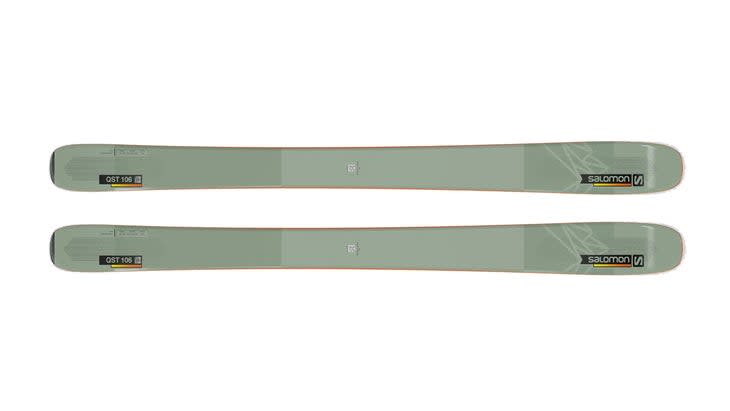
Salomon QST 106 ($850)
Dimensions: 139/106/125
The QST 106 isn't particularly new, but that doesn't matter. This fun and lively ski is still one of the best all mountain powder skis we've ever tested--for a certain type of skier. It doesn't have any metal in it. Then again, if you ski in trees and well spaced bumps and tend to pop out of the snow on powder days, or if you spend your days after storms hiking for turns inbounds and searching for powder scraps more than you do arcing turns on groomers, then you probably don't need a ski with two sheets of alloy anyway. That adventurous style of skiing is the QST 106's raison d'etre. It's damp but not dead, and it delivers a ride with some zip. "It just levitates out of crud and lets you change direction without mucking each turn," said a tester. Credit rests with Salomon's complex matrix of fibers intended to mimic metal's dampening and torsional strength, without the added weight. "Possibly the most maneuverable ski in the All Mountain Powder test," said a reviewer. "But it's not just an off-trail ski. The edging is crisp and precise and the sweet spot is huge."
Gripe: Our only complaint has to do with how we rank skis. Much of ski selection comes down to personal preference in regards to terrain choices and ski feel. For a large section of the market that likes to explore, the QST 106 is a top ski. For some former racers it might be a little too surfy and playful.
Like: "The best attribute of the QST 106 is how natural it feels to ski on," said a tester. "You don't need to figure it out."
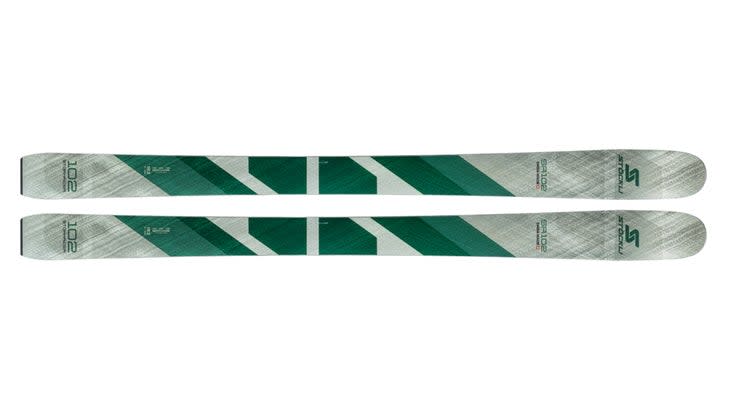
Stockli Stormrider 102 ($1,249)
Dimensions: 135/102/125
The Stormrider 102 is the counterpoint to the Salomon QST 106. Look to the 102 if you favor stability at cruising speeds over a sprightly feel. Not that the Stormrider is challenging to pilot: like most modern skis, this Stockli features a deep and consistent flex that makes it approachable to a huge range of skiers, from lightweights with less skill to heavy chargers. But the Swiss refuse to trade stability, edge penetration, and dampening for weight savings. "I love the Stockli feel when it's time to cruise and send big arcs," said a tester. "It's best in class for high-speed turns." That performance is due to the company's ultra-premium construction. It takes days to build a Stockli ski by hand with this much attention to detail, which is part of the reason why these Swiss skis last longer than those of their mass-market competitors. They also employ the best materials available: everything from the species in the wood core (paulownia), to the edges (solid metal) and base materials (racing graphite) are sourced to to last longer while retaining performance. "As soon as you make your first turn, you can tell this is a quality build," said a tester. "They'll probably still feel fresh in year three."
Gripe: Most of our testers would like a slightly more dynamic ride from the Stormrider.
Like: When conditions get firm, you won't feel the need to go get another set of skis out of the truck. For such a user-friendly ski, the edgehold is also best in class.
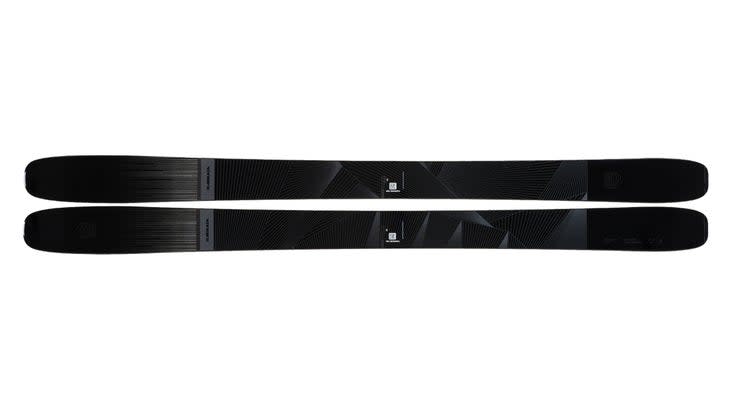
Armada Declivity 108 Ti ($925)
Dimensions: 136/108/126
Armada is the original park and pipe brand. But the Declivity is a kick ass, directional all mountain ski with two sheets of metal, stout vertical sidewalls, and full wood cores--a far cry from the twin tips the brand was founded on. That doesn't mean Armada has lost its way. The Declivity 108 Ti, one of the most deeply rockered skis in the test, surfs and slashes just as adeptly as it carves and trucks. "Turns on a whim; smears at will, but holds a clean arc when it's time to open it up," said a tester. That versatility is due to modern footprint and construction. The rocker is deep, but not so deep that a skilled skier can't engage the edges on groomed snow. And while the two sheets of titanium alloy boost the damping and stability, smart cutaways in the top layer of metal let the ski flex deeply into all sizes of turns. "You can open them up and shut them down effortlessly," said a tester. "This was one of the more fun skis off-trail."
Gripe: We would like a bit more life out of the ski through transitions on groomed snow.
Like: If you ski off-trail in new or chopped snow 80 percent of the time, you can't go wrong with the 108. That deep rocker shines in mank, breakable crust, and tracked pow.
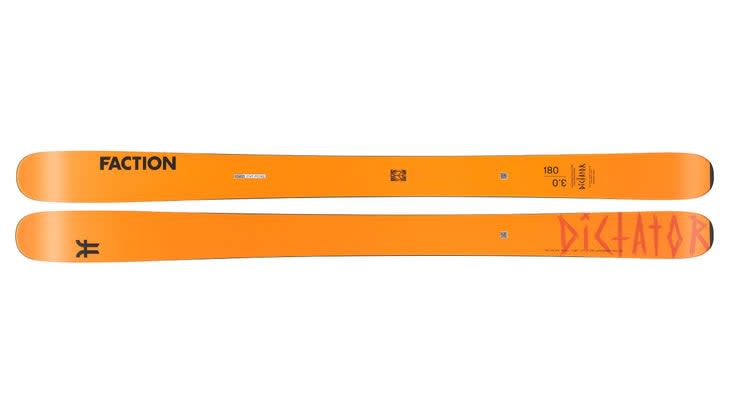
Faction Dictator 3.0 ($819)
Dimensions: 134/106/124
There are lots of skis to choose from in this category, but they aren't all the same. Take the Dictator 3.0 as evidence. The sidecut is less than most of the skis on this page--dimensions indicate a large, 23-meter turn radius. That straighter shaping is a boon off-trail (skis with less sidecut don't hook as much in weird snow) and you can arc whatever turn shape you like depending on how hard you push. "Super dynamic and fun ski," said our heaviest tester. "There's a low barrier to entry: you can ski it slow and relaxed, but there's enough power here for aggressive skiers too." Faction got the balance correct. The rocker works with the camber, the flex matches the sidecut, and the torsional strength delivers a crisp feel and good feedback in soft to medium-hard snow. You can go full throttle on-trail or off-trail. "Holds an edge really well, but you can butter it around with ease too," said a tester. "It has the accessible power that's the hallmark of modern ski design."
Gripe: It's rare for us to want more sidecut in an All Mountain Powder ski, but just a smidge more up front would make it easier to roll this 108 into a carve. And we'd take a hair more stability too. There's a bit of nervous deflection in chunder.
Like: We would not hesitate to mount this Dictator with hybrid crossover bindings like the Salomon Shift or the Duke PT and ski it in the backcountry.
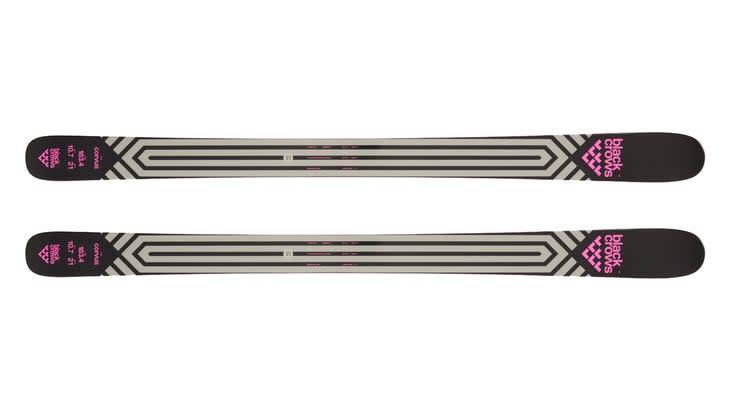
Black Crows Corvus ($870)
Dimensions: 137/107/126
The skis in this category typically excel at off-trail skiing in soft snow 70 percent of the time, but rip decent turns on groomers or alpine snow the other 30 percent. We'd put the Corvus at an 85/15 ratio. The Corvus is the only fully rockered ski we tested last year. The tip splay is more pronounced than any ski in the test. And the 21-meter turn radius is stretched out for off-trail skiing. As such, it skis like a powder specialty ski. "Very easy to pivot and maneuver," said a tester. "Great for tree skiing or steeps; no speed limit in crud or old pow." That's all in keeping with Crow heritage: the brand was born off-piste in the French Alps. And if you live out West and seldom ski machine groomed snow, it just might suit you as well. A full wood core and vertical sidewalls plus a consistent flex make it predictable in wild terrain and all snow types. As for that 15 percent of groomer time? The Corvus is fun there too once you've figured out how to ski it. Reverse camber skis demand a subtle pilot able to baby the belly of the turn as you eke out gentle arcs.
Gripe: Babying the belly gets old.
Like: Skis like the Corvus are hard to find these days, but you can't discount how they make bad snow good. "Tracks and blasts off-trail in chop, pow, or crud," said a tester.
Women's All Mountain Powder
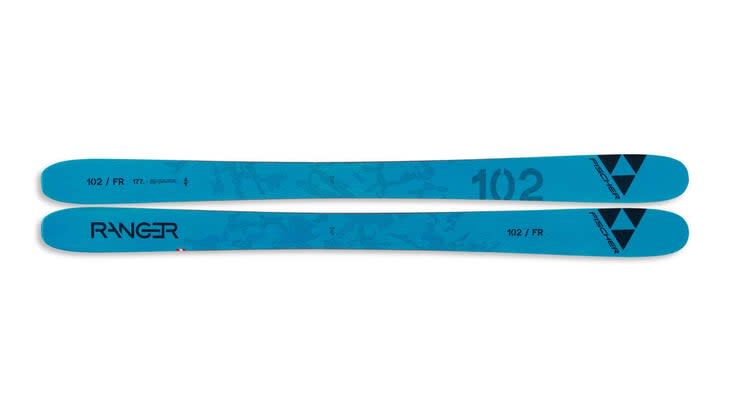
Fischer Ranger 102 FR ($799)
Dimensions: 136/102/126
Fischer is of the school that skis don't recognize gender. Which means that our team of women testers reviewed the same unisex ski that the men ran: the men scored it as the best in the test, and the women ranked it as their runner-up. Fischer is acting on what a lot of skiers have known for 20 years--gender doesn't mean much when it comes to skis. "Snappy but easy to shut down; tons of stability and edgehold but surfy and fun at the same time," said a tester. These powder skis don't even need powder to be fun," said another. This broad range of gender neutral appeal all makes sense when you have a little context. The goal of modern ski construction is to produce skis with accessible power, meaning the skis are forgiving and smooth at low speeds when you're taking it easy, but they get progressively more powered up as you increase velocity and turn more dynamically. When you build such balanced skis, a huge range of skiers and body types can rip on them. That's the Ranger 102 FR. Air channels in the core plus a carbon nose mean it's light enough to swing around easily, but it's also stout enough--two sheets of titanium alloy and vertical sidewalls--to edge powerfully on hardpack at high speeds. Just the right amount of torsional strength gives it good pop from turn to turn.
Gripe: In the deepest of inbounds powder days, there might not be enough width here to win the flotation award.
Like: There's so much hardpack performance here that you may never want a skinnier ski.
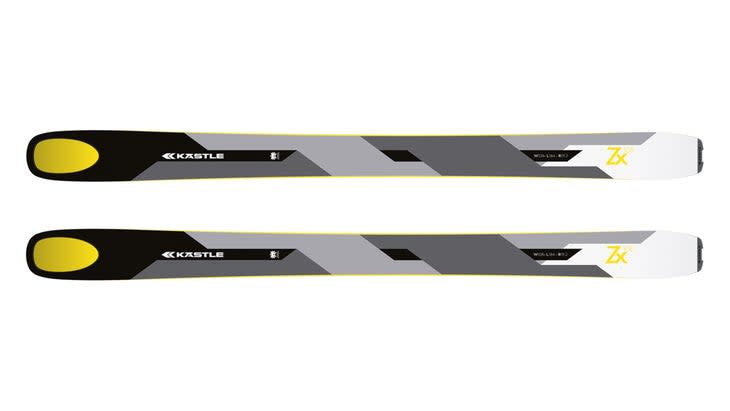
Kastle ZX108 ( $799)
Dimensions: 141/108/130
Here's another unisex All Mountain Powder ski that our women testers loved. We think it's simply because, with the ZX108, Kastle got the flex right and paid attention to the overall weight of what is one of the fattest skis we tested. Unlike almost every Kastle we've skied until recently, there aren't two burly sheets of titanal alloy under the hood here. Instead, to deliver some guts, the Austrian brand's designers trusted the damping and stability of its poplar and beech core. With the right blend of progressive, not abrupt, rocker and a longer shovel with less pronounced sidecut (what Kastle calls "hook free" shaping), it has a comfortably loose feel. Vertical sidewalls give it plenty of edge bite. And trust us, we had plenty of hard snow beneath the fresh stuff in Steamboat to put this ski through its paces. "These ZXs feel so much easier to ski than Kastles of years past," said a tester. "Solid but playful, strong edgehold, but easy to break out of a turn. They love making an 18-meter turn, but you can squirrel around on them too. One of the most versatile Kastles I've ever skied."
Gripe: The classic Kastle "hollowtech" tip makes for some tip flutter on hardpack. We understand that swing weight matters, but not at the expense of chatter. Maybe it's time to ditch it?
Like: "Fluid from one turn to the next," said a tester. "When I threw them sideways I could trust they were going to hold me."
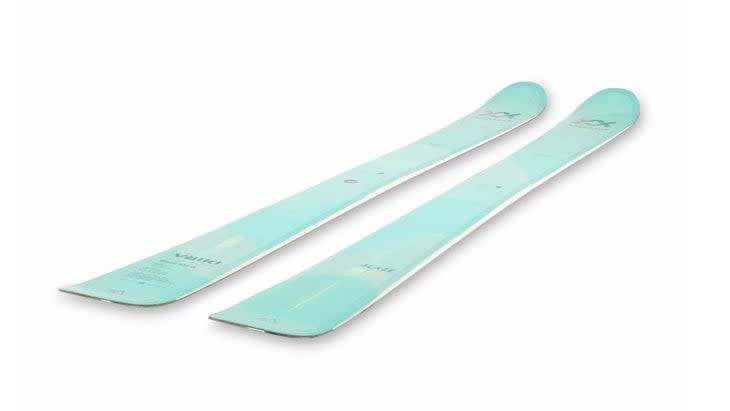
Volkl Blaze 106 W ($700)
Dimensions: 146/106/128
The Blaze line was originally envisioned for freeride, which is Euro-speak for a ski that can cross over to the backcountry but still rip inbounds. There's no metal in the Blaze other than a thin titanal binding plate. And the rocker is substantial, extending down the ski well past the point where most of the All Mountain Powder skis we tested reverted to camber. As with the unisex version of this ski, the Blaze 106 W was one of the best Volkl's we've skied in years. Gone is the "glassy" twitchiness of the brand's titanal frame construction. In its place is a silky ride with deceptive edgehold. As you'd expect for a freeride/crossover ski, the 106 W is also lightweight. The 172-centimeter length only weighs 1,670 grams per ski. "I cannot believe how well these things arc," said one tester. "They feel super stable and stuck to the snow when edging, but loose and surfy when it's time to pivot some powder turns or navigate tight terrain." The Blaze's versatility comes from the shaping of the ski. It sports a modern multi-radii sidecut (stretched out in the tip and tail for stability; more of an hourglass underfoot for belly arcs), but that type of differential only works well when, like in the Blaze, the rocker is pronounced enough to keep that wide, 146-millimeter tip from hooking.
Gripe: It's more damp than it is lively, but for a ski with so little metal, that can be the tradeoff for stability.
Like: "This ski does everything so well I could ski it every day in Colorado--and tour on it too."
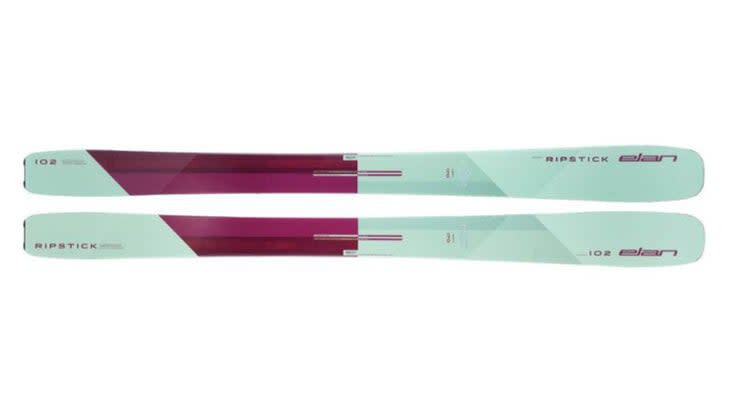
Elan Ripstick 102 W ($800)
Dimensions: 136/102/115
"Effortless," said one tester. "Each turn runs into the next without a thought. Even in tracked up chunder, the skis never feel hooky and seem to slink down the fall line. It's like the ski is on autopilot. But not in a dull way. The 102 delivers a lively and entertaining ride when you push into the flex and rail the sidecut." That's pretty much what Elan intended with this ultra-versatile ski. Mount it with a hybrid resort/backcountry binding and you could ski it almost everywhere all the time. It's a shapeshifter by design. Elan's unique Amphibio footprint means the skis are asymmetrical, featuring more rocker on the outside edges. This produces a loose and forgiving feel that is super easy to ski. But new carbon reinforcement over the inside edges means the 102 also rips on hardpack. The Ripsticks ski like nothing else on the market: Elan is in Slovenia, away from the incestuous ski manufacturing of the Germanic and Franco countries. Case in point, instead of metal, Elan installs carbon rods in the core of the Ripsticks to help the ski hang onto the energy of a turn through the transition.
Gripe: At top speeds on hard snow there is a speed limit. (Though, if you ski that fast they'll pull your ticket.)
Like: The tip is wide compared to the tail, and once you set up a high edge angle turn it pulls you through.
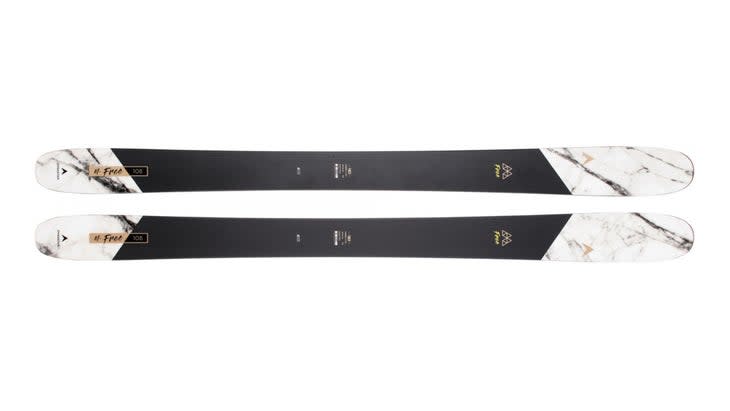
Dynastar M-Free 108 ($800)
Dimensions: 138/108/128
Looking for a true powder ski? The M-Free 108 was the surfiest, loosest big-day ski we tested in Steamboat. Another unisex ski--a trend in this category--the M-Free 108 features a hybrid core of polyurethane and wood, with no metal sheeting in order to save weight and offer a uniquely silky ride (the PU eats vibration). Pronounced tip and tail rocker make it easy to pivot, and a full sandwich construction boosts edgehold. "Smooth, almost polished, turns in all manner of soft snow," said a tester. "This Dynastar is super agile and fun off-trail. You can mix up the turn shape, but you can also settle into a nice round arc." Last year both test teams loved the 108 on soft corduroy and powder. This year, when the snow was skied off to reveal legit hardpack, the lack of metal and a full wood core hurt the M Free a bit.
Gripe: On the really firm stuff, the M-Free suffered from a bit of tip flutter, and while the edging was robust enough, it wasn't best in class.
Like: A 108 with pure powder tendencies, the M-Free is built for good days inbounds and out. "I only break out skis this fat when there's new snow on the hill or I'm touring," said a tester. "And for those scenarios, I want a more playful ski like this one anyway. It will make the best powder days better."
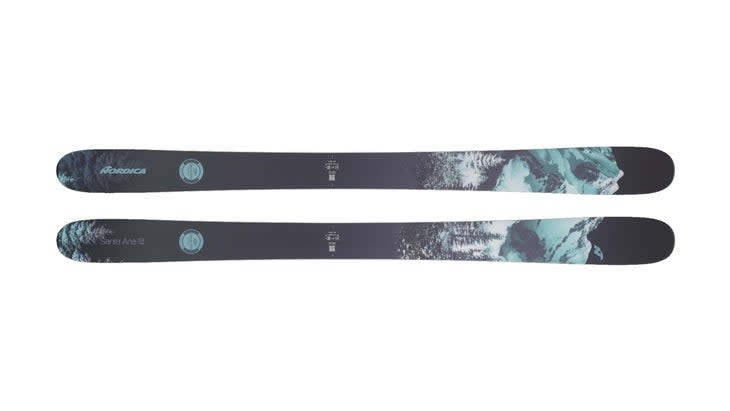
Nordica Santa Ana 104 Free ($850)
Dimensions: 134/104/123
The Santa Ana 104 Free W gets the same footprint and shaping as the revolutionary Enforcer 104 Free, but to dial in the performance for lighterweight woman skiers, Nordica incorporated a laser-cut sheet of titanium alloy, which reduces mass, backed by a mix of carbon and fiberglass weave. The key point of all that tech is that while Nordica focused on saving weight--crucial in skis over 100mm--they also were careful to add performance enhancing materials back into the ski. It's counterintuitive, but a ski that's a few grams too light can actually take more energy to control, while a ski that tracks properly and carries a few extra grams will save your strength. On the hill, the 104 excels off-trail in all manner of soft snow, but its edging performance makes it way more adept at carving than one might think. Said our women's test director: "You can ski it fast. You can ski it slow. You can charge through broken crud. You can lay it on edge and carve big turns. It's one of the most versatile AMP skis of all time."
Gripe: There was no consensus critique. But one tester thought it could ski a bit looser still.
Like: This was our women's test director's top ski. If you ski in the west and spend 70 percent of your time off-trail, the Santa Ana is an easy selection. "For an advanced to expert skier out West it does it all," she said. "It will set you free from worrying about what ski to bring to the hill."
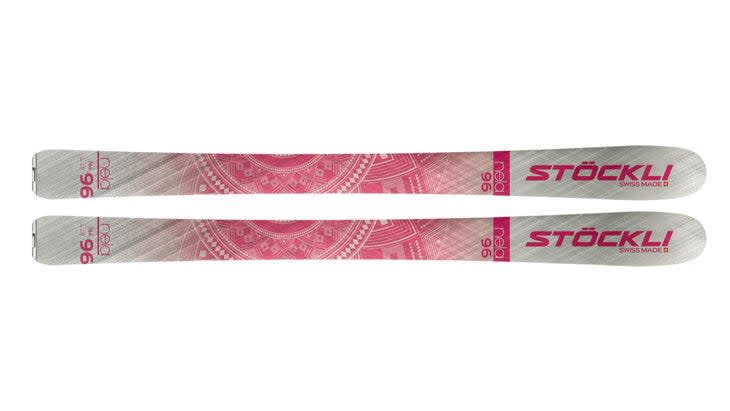
Stockli Nela 96 ($1,049)
Dimensions: 134/96/121
At 96 millimeters underfoot, the Stockli Nela is 20 millimeters skinnier than the fattest skis in this category. But if you're a petite skier who skis more six-inch storms than multi-foot dumps, this ski might be wide enough for you, since lighter weight people don't need as much ski surface area to float in soft snow. Better still, when the fresh stuff is skied off, the 96 is easier to tip into linked turns on groomers. And now a caveat: It takes a bit more skill to pilot a 96-millimeter ski through snow that's boot top or deeper. "I love skis this width in blower powder on top of corduroy," said a tester. "Get those conditions and the snow will be spilling over your shoulders." Other testers praised the Nela for its ability to carve big turns and slink through bumps. As for the price tag, it's high because of quality, not marketing. You're paying for titanium alloy, a long-lasting paulownia wood core, and the hardest/fastest graphite race bases money can buy.
Gripe: Many of our testers thought the Nela was better suited to the skinnier All Mountain category.
Like: The fact that a 96-millimeter ski performed so well here is testament to its capabilities. Our advice? Think carefully about your size and how much powder you typically ski in a season before deciding on a ski width.
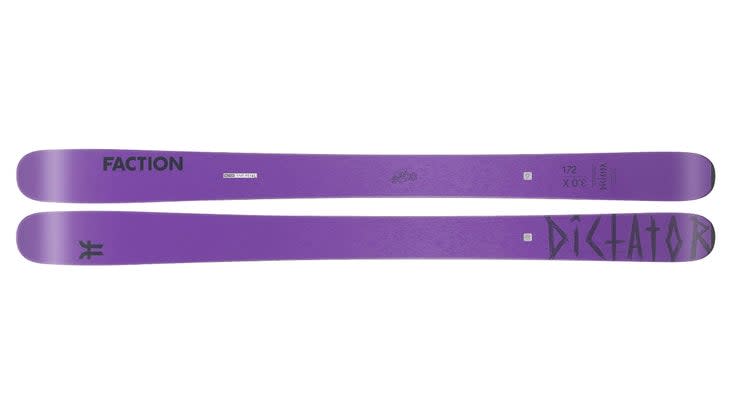
Faction Dictator 3.0X ($819)
Dimensions: 134/106/124
The Dictator line features full stout poplar cores and two sheets of metal throughout for stability at speed. The tails are flat, meaning they're built for directional skiing rather than a slashy pivoting style. And the vertical sidewalls and rugged 2.5-millimeter edges spell edgehold and durability. All of which means that the Dictator 3.0X--the only difference from the unisex ski is the graphic--is made for those who want to ski fast and arc big turns. But don't be intimidated, it's not just a ski for elites. "This Dictator is super forgiving at the beginning of the turn, with a soft flex and easy turn initiation," said a tester. "You can smear it around when you want, but if you're feeling like charging off-trail the tail really holds on." All of which is to say that the 3.0X is in keeping with modern ski design that accommodates a range of skier types on a range of terrain. At slow speeds it's responsive and forgiving. At mach five there's that tail and beefy construction to push off of.
Gripe: It's actually well suited to bowl skiing or alpine snow, but on hardpack the turn really doesn't engage powerfully until you're pressuring your heels.
Like: "I ski off-trail 85 percent of the time and that's where the Dictator shines," said a tester. "The shovel is big and compliant and bashes through crud. The tail is all business. It's a perfect mullet."
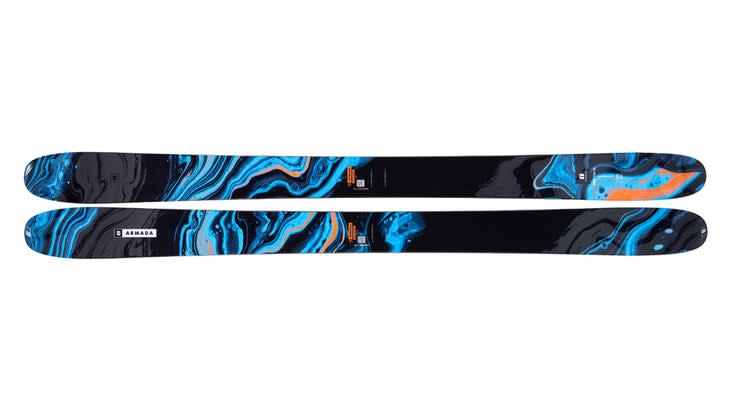
Armada ARW 106 UL ($825)
Dimensions: 134/106/124
Surf, slash, smear, pivot, float, pop: if you're looking for the most playful of the All Mountain Powder skis, the ARW 106 UL is it. The UL stands for ultralight, and as to be expected there's no metal in this freerider other than the edges. A feathery caruba wood core saves additional weight and makes those pivot turns still easier. And the pronounced tip and tail rocker means you can smear them around at will to change direction in the woods or dump speed in the big wide open. Those same characteristics make it welcoming to advanced skiers looking to explore bigger terrain. "Incredibly user-friendly," said a tester. "The flex and rocker is ultra forgiving, but they do not waver at speed, especially in chopped up snow. You can plow and float through everything." Part of that maneuverability, especially at slow speeds in soft snow, is from what Armada calls "Smear Tech:" the edges of the ski stop up near the tip so there's nothing to grab as you whip the skis around.
Gripe: Yes, a ski this playful and off-trail focused naturally has to trade some carving attributes, and the ARW does, but in good snow it makes a surprisingly consistent round arc when you want to carve medium radius turns.
Like: By far the best tree-skiing tool in the test. That's when pivot turns and smearing matter most.
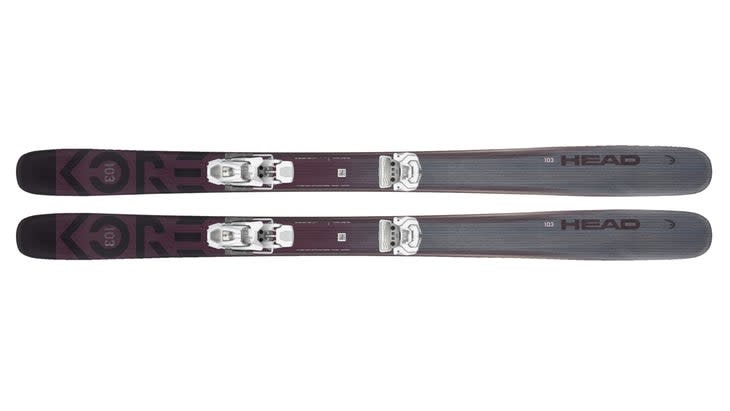
Head Kore 103 W ($875)
Dimensions: 132/103/123
Way back in 2017, Head became the first brand to make a lightweight ski that wasn't skittery as hell. They did that by incorporating advanced materials like Koroyd (that honeycomb polymer you've seen in bike helmets) and graphene--the lightest, strongest material on earth. Despite the low weight--an impressive 1,750 grams per ski--their skis hook up and hold on in a tip-to-tail turn. And even when straight running, the skis don't ping around like other lightweights. All that is true with the brand-new Kore 103 W, even as Head has moved on from Koroyd, which deadened the skis, and focused its efforts on reinforcing the lightweight caruba wood core with carbon. "Really stays the course at speed," said a woman tester who skis exceedingly fast. "It's stable and predictable and skis heavy, even though it's not." So who should buy the Kore? If you're a lightweight and you want to cruise more than you want to pop from turn to turn, this damp but easy ski is perhaps the most approachable model in the entire test. Thanks to its forgiving flex and rocker, it accommodates pilot miscues while still offering a carved turn.
Gripe: The Kore 103 still favors the damp and predictable over the energized. Our most dynamic skiers thought it was a bit sleepy.
Like: For a huge chunk of the easy-skiing market--those mid-velocity cruisers on blue runs and gentle back bowls--the Kore 103 W is a trusted friend.
Unisex Pure Powder Skis
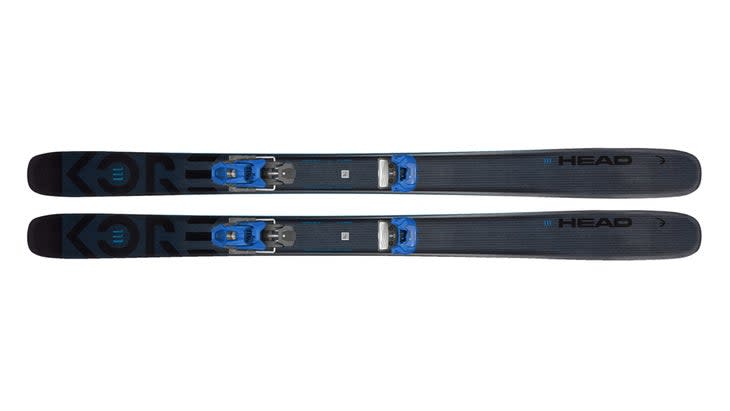
Head Kore 111 ($875)
Dimensions: 140/111/127
Like the Salomon QST Blank, the new Kore 111 Freeride was built at the request of pro skiers from the big-mountain and film-skiing worlds. In a few ways the skis are similar. The Kore line also forgoes titanal in favor of weight-saving materials like graphene and multiple applications of carbon fiber. That space-age stuff reinforces a lightweight caruba and poplar core with a big, even flex profile. As expected, the tip and tail are more deeply rockered than in any other Kore. So, it's another lightweight pow ski with enough sidecut (21-meter radius in the 184-centimeter length) for inbounds skiing where you're actually engaging the geometry to turn as opposed to smearing the skis around on some Alaskan face. But that's where the comparisons between these two Powder Freaks end. Where the Blank is lively and poppy in the QST style, the 111 is a Kore to its core. "Impressively damp and stable," said a tester. "Especially in soft snow, this ski is unwavering. It excels on open faces and wide open terrain where the bashing power takes over." And that speaks to who should buy this big-day ski. If you stick to open slopes and ski a lot of new snow each winter, the 111 is a stout and floaty weapon. Ditto if you're keen to mount a pair with hybrid resort/backcountry bindings and head to similar terrain on wild snow. They're big and easy to ski and never twitch or shudder. Just don't look here if tight trees are your jam. The 111's are light, but they ski kind of heavy.
Gripe: It's not a critique, but that bashing power comes at the price of playfulness.
Like: Head made it in a 191, which is a much needed length for large human beings who shred.
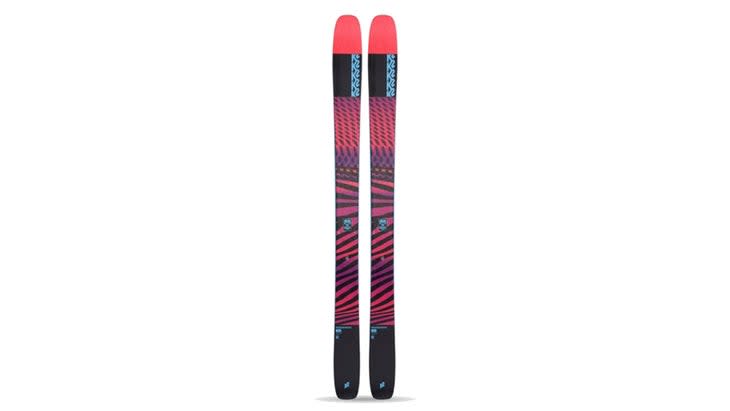
K2 Mindbender 116C ($850)
Dimensions: 143/116/133
We were frankly a little scared of the Mindbender 116C, which is nearly a centimeter wider than the widest ski in the test and gives off old-school big-mountain vibes. We were way off base. The Mindbender 116C wasn't just nimble for such a fat pow ski, it was nimble by all standards. "K2's best ski in years," said a tester. "So supple and soft but at the same time the edgehold was amazing." Blissfully, there's no metal in this ski, which at this width would make the Mindbender feel like an anchor. Instead, K2's unique weave of fibers (they call it Spectral Braid) incorporates carbon as a weight-saving device. It's a tricky material to work with. Add too much and a ski gets nervous, add too little and you don't see the weight savings or boost in torsion. K2 nailed it here. "Unbelievably easy to ski," said a tester who was shocked that a 116 could be this sprightly. "It makes every turn shape from short swings to super-G."
Gripe: It's not a gripe, just a distinction. Skis this wide, no matter how deft, are more suited for the best days of the year when the canyon is closed behind you and the snow keeps on coming. On hardpack, that extra width isn't all that good for your knees.
Like: There is no doubt that owning a ski with these dimensions can make the best days better and at the same time make the worst days (breakable crud) fun too. The 116c rounds out a quiver.

